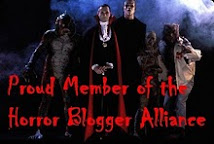The film is an adaption-in-name-only of an Edgar Allan Poe story of the same name, which tells of an ill-fated sea voyage and the dark secret locked away in one piece of cargo. The film, on the other hand, dabbles in voodoo, grave robbing, revenge, and madness with Price starring as a man whose brother is disfigured thanks to a curse by an African tribe and condemned to live locked up in one room on the family estate. Driven mad by circumstance, the brother - played by the primarily masked and character actor Alister Williamson - is made to appear dead by another witch doctor, and escapes from his brother's reign after being buried alive in a coffin that is - you guessed it - oblong in shape. (By the way, this guy gets my respect for trusting a witch doctor AFTER he's already been cursed and deformed by a witch doctor. That's some surprising trust.)
What follows is a neat horror story that lives somewhere between Frankenstein and the modern slasher film that may have drawn some inspiration from the German "krimi" films of the 1960s. The devious and disfigured brother, Edward, is risen from the grave by his co-conspirators and then dons a red mask and goes on a spree of madness against those who wronged him (and the occasional shifty prostitute who tries to overcharge him for ripping her breast from her gown). He's actually a pretty fantastic villain, spouting rage-filled dialogue from behind the hood and showing off his imposing size as he moves through the film. Lee co-stars as the doctor who unwillingly takes in Edward and provides him a home, and perhaps the most lasting image of the film is how it manages to make us think Edward is towering over and dominating the 6'3" man who made Dracula seem taller than Godzilla.
The Oblong Box is directed by Gordon Hessler, who would make two more films with Price the following year - Scream and Scream Again and Cry of the Banshee being the others, and the director brings a vision that seems more in tune with the pulse of its era than many other Gothic horror films of the time. The film is not exceedingly violent, even by the standards of 1969, but the masked killer is something quite different for the time period. And the fact that he is made to look stronger than both Lee - who spends much of the movie trying to sound tough but never really threatening Edward - and Price - who is in that "tortured soul who would be good if it weren't for his secret" role that he does so well - does wonders for the film. We don't expect to see Christopher Lee and Vincent Price both losing out to one villain in a horror film, and the fact that Hessler offers that for much of this film is a bold and kind of brilliant twist on the viewer's expectations.
Though the film was produced on a low budget for American International Pictures, there's definitely a grand feeling to the story at times. The script is attributed to two writers: Lawrence Huntington, who died at the age of 68 in the year before the film's release, and Christopher Wicking, a twenty-six year old writer who re-wrote the script that Huntington and original director Michael Reeves (who also died during production) had put together. Despite the number of contributors and the unfortunate circumstance around the film, it still offers some interesting twists. There's a bit of psychological play - led by the strange sexual relationship between the killer and pretty young servant and some late film showdowns between Price's character and his brother - and I definitely felt like the film was turning toward the new breed of horror that had been started by films like Night of the Living Dead and Rosemary's Baby in 1968. I am a big fan of Price/Poe films like those made by Roger Corman, of course, but it's easy to see that The Oblong Box was conceived from a different mindset than those films.
The end result is a macabre piece of horror that manages to create something new without wasting the talents of its two iconic stars. It's funny to me that the thing that drew me to this film was the pairing of Lee and Price, and yet it's probably the thing I'm least interested in talking about right now. If you're a fan of these icons you know what you're getting from them (Repeated Warning: it's not the dominating villain role for either, so check your expectations accordingly), which makes it important to know that most of the things around them - particularly Williamson and whoever provided his character's voice - are fantastic on their own. The Oblong Box is not what you might expect, but if you expect good horror cinema you could do a whole lot worse.
















2 comments:
I want to bugger Hilary Dwyer (as the bird was in 1963 when the bird was 18, not as the bird is now obviously).
So do i ! ! !.
Post a Comment